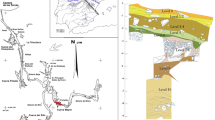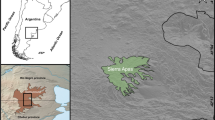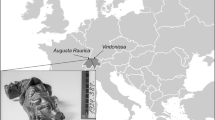Abstract
Small dogs as pets, objects of affection and special consideration by their owners, are known in the Western Mediterranean since classical Antiquity through texts, epigraphy and iconography. The study of a small-sized canid with a brachycephalic skull discovered in a cemetery, among other specimens, in the southern Hispania yields new interpretations regarding the relationships between dogs and humans at the outset of the Common Era in the western Roman world and sheds light on how to evaluate their symbolic implications in funerary rites. The physical characteristics of these specimens were analysed through morphological, osteometric, palaeopathological and biochemical isotopes methods. The findings represent a step forward in the understanding of the everyday life, mobility and diet of dogs, as well as the cause of their death which, in the case of the small-sized specimen, appears to correspond to a deliberate sacrifice.








Similar content being viewed by others
References
Albizuri S, Nadal J, Martín P, Gibaja JF, Martín A, Esteve X, Oms FX, Martí M, Pou R, López D, Subirà ME (2019) Dogs in funerary contexts during the Middle Neolithic in the northeastern Iberian Peninsula (5th–early 4th millennium BCE). J Archaeol Sci Rep 24:198–207. https://doi.org/10.1016/j.jasrep.2019.01.004
Altuna J (1994) El perro en los yacimientos arqueológicos del norte de la Península Ibérica. In: Homenaje al Dr Joaquín González Echegaray: Santillana del Mar, pp 159–162
Altuna J, Mariezkurrena K (1992) Perros enanos en yacimientos romanos de la Península Ibérica. Archaeofauna 1:83–86
Araguas-Araguas L, Díaz-Teijeiro MF (2005) Isotope composition of precipitation and water vapour in the Iberian Peninsula. Isotopic composition of precipitation in the Mediterranean Basin in relation to air circulation patterns and climate. Final report of a coordinated research project 2000–2004. IAEA-TECDOC-1453 ; 173–190
Barberan S, Convertini F, Delage R, Gafa R, Maufras O, Pellé R, Raux S, Rodet-Belarbi I (2014) Un dépotoir des années 70-110 de n. è. au bord de la voie Domitienne et près de la porte d’Auguste (Nîmes, Gard). Rev Archéol Narbonnaise 47:155–239
Barone R (1976) Anatomie comparée des mammifères domestiques. Vigot Frères, Paris
Baxter IL (2006) A dwarf hound skeleton from a Romano-British grave at York Road, Leicester, England, U.K., with a discussion of other Roman small dog types and speculation regarding their respective aetiologies. Dogs and People in Social, Working, Economic or Symbolic Interaction, MS Lynn, AM Elizabeth (eds.). Oxbow Books, Proceedings of the 9th ICAZ Conference: Durham; 12–23
Baxter IL (2010) Small Roman Dogs. Alexandria Archive, Bone Commons
Bender MM (1971) Variations in the 13C/12C ratios of plants in relation to the pathway of photosynthetic carbon dioxide fixation. Phytochemistry 10:1239–1244
Bisuttil J (1969) The Maltese dog. Greece Rome 16:205–208
Bocherens H, Fizet M, Mariotti A, Vandermeersch B, Borel JP, Bellon G (1991) Isotopic biogeochemistry (13C, 15N) of fossil vertebrate collagen: application to the study of a past food web including Neandertal man. J Hum Evol 20:481–492
Catagnano V (2016) Aproximación morfométrica y paleogenética al estudio de la variabilidad de Canis l. familiaris en la Peninsula Ibérica desde el Neolítico hasta época romana y su contextualización en el ámbito del Mediterráneo Occidental. PhD Thesis, Departament de Prehistoria, Universitat Autònoma de Barcelona: Barcelona
Colominas L (2016) Morphometric variability of Roman dogs in Hispania Tarraconensis: the case study of the Vila de Madrid Necropolis. Int J Osteoarchaeol 26(5):897–905. https://doi.org/10.1002/oa.2507
Courtney E (1995) Musa Lapidaria. A selection of latin verse inscriptions. Scholars Press, Atlanta
Craig OE, Biazzo M, O’Connell TC, Gransey P, Martínez C, Lelli R, Salvadei L, Tartaglia G, Nava A, Renò L, Fiammeghi A, Rickards O, Bondoli L (2009) Stable isotopic evidence for diet at the Imperial Roman Coastal Site of Velia (1st and 2nd Centuries AD) in Southern Italy. Am J Phys Anthropol 139:572–583
Day LP (1984) Dog burials in the Greek world. Am J Archaeol 88:21–32
Daza A (2017) Preliminary studies of late prehistoric dog (Canis lupus f. familiaris Linnaeus, 1758) remains from the Iberian Peninsula: osteometric and 2D geometric morphometric approaches. Papers from the Institute of Archaeology 27: 1–21. https://doi.org/10.5334/pia-487
De Grossi J, Minniti C (2006) Dog sacrifice in the ancient world: a ritual passage?. Dogs and People in Social, Working, Economic or Symbolic Interaction, M Snyder, E Morre (eds.). 9th ICAZ Conference, Durham 2002, Oxbow Books: Oxford; 62–66
De Grossi J, Tagliacozzo A (1997) Dog remains in Italy from the Neolithic to the Roman Period. Anthropozoologica 25–26:429–440
De Grossi J, Tagliacozzo A (2000) Morphological and osteological changes in the dog from the Neolithic to the Roman period in Italy. In: Crockford J (ed) Dogs Through Time: An Archaeological Perspective, British Archaeological Reports International Series 889, Oxford, pp 141–161
Delgado A, Iacumin P, Stenni B, Sanchez B, Longinelli A (1995) Oxygen isotope variations in mammalian bone and tooth enamel. Geochim Cosmochim Acta 59:4299–4305
DeNiro MJ (1985) Post-mortem preservation and alteration of in-vivo bone collagen isotope ratios in relation to paleodietary reconstruction. Nature 317:806–809
DeNiro MJ, Epstein S (1978) Influence of diet on the distribution of carbon isotopes in animals. Geochim Cosmochim Acta 42:495–506
DeNiro MJ, Epstein S (1981) Influence of diet on the distribution of nitrogen isotopes in animals. Geochim Cosmochim Acta 45:341–351
DeNiro MJ, Schoeniger MJ (1983) Stable carbon and nitrogen isotope ratios of bone-collagen - variations within individuals, between sexes, and within populations raised on monotonous diets. J Archaeol Sci 10:199–203
Detry C, Cardoso JL (2010) On some remains of dog (Canis familiaris) from the Mesolithic shell-middens of Muge, Portugal. J Archaeol Sci 37:2762–2774. https://doi.org/10.1016/j.jas.2010.06.011
Driesch AVD (1976) A guide to the measurement of animal bones from archaeological sites. Peabody Museum, Harvard University, Cambridge
Grandal-d’Anglade A, Albizuri S, Nieto A, Majó T, Agustí B, Alonso N, Antolín F, López JB, Moya A, Rodríguez A, Palomo A (2019) Dogs and foxes in Early-Middle Bronze Age funerary structures in the northeast of the Iberian Peninsula: human control of canid diet at the sites of Can Roqueta (Barcelona) and Minferri (Lleida). Archaeol Anthropol Sci 11:3949–3978. https://doi.org/10.1007/s12520-019-00781-z
Guiry EJ (2012) Dogs as analogs in stable isotope-based human paleodietary reconstructions: a review and considerations for future use. J Archaeol Method Theory 19:351–376. https://doi.org/10.1007/s10816-011-9118-z
Habermehl KH (1975) Die Altersbestimmung bei Haus- und Labortieren. Paul Parey Verlag, Berlin
Harcourt R (1974) The dog in prehistoric and early historic Britain. J Archaeol Sci 1:151–175
Hawthorne JC, Blevins WE, Wallace LJ, Glickman N, Waters DJ (1999) Cervical vertebral fractures in 56 dogs: a retrospective study. J Am Anim Hosp Assoc 35:135–146
Hillson S (2005) Teeth. Cambridge University Press, Cambridge
Horard-Herbin M (2000) Dog management and use in the late Iron Age: the evidence from the gallic site of Levroux (France). In: Crockford J (ed) Dogs Through Time: And Archaeological Perspective. British Archaeological Reports International Series 889, Oxford, pp 115–121
Hourani Y (2018) Persian period dog burials of Beirut: morphology, health, mortality and mortuary practices.Archeozoology of the Near East XII. Proceedings of the 12th International Symposium of the ICAZ Archaeozoology of Southwest Asia and Adjacent Areas Working Group, C Çakirlar, J Chahoud, R Berthon, SE Pilaar Birch (eds.). Barkhuis Publishing & University of Groningen: Groningen; 153-184
Iacumin P, Bocherens H, Mariotti A, Longinelli A (1996) Oxygen isotope analyses of co-existing carbonate and phosphate in biogenic apatite: a way to monitor diagenetic alteration of bone phosphate? Earth Planet Sci Lett 142:1–6
Iborra MP (2017) Arqueozoología de época romana en el País Valenciano. Archaeofauna 26:23–38
Ikram S (2005) The loved ones: Egyptian animal mummies as cultural and environmental indicators. In: Buitenhuis H, Choyke A, Martin L, Bartosiewicz L, Mashkour M (eds) Archaeozoology of the Near East. ARC, Groningen, pp 240–248
Laffranchi Z, Huertas AD, Jiménez Brobeil SA, Torres AG, Riquelme Cantal JA (2016) Stable C & N isotopes in 2100 year-B.P. human bone collagen indicate rare dietary dominance of C4 plants in NE-Italy. Nat Sci Rep 6:38817. https://doi.org/10.1038/srep38817
Lee-Thorp JA, Sealy JC, Van Der Merwe NJ (1989) Stable carbon isotope ratio differences between bone collagen and bone apatite and their relationship to diet. J Archaeol Sci 16:585–599
Lepetz S (1993) Les restes animaux dans les sépultures gallo-romaines. Monde des morts, monde des vivants en Gaule rurale, Actes du Colloque ARCHEA/AGER (Orléans, 7–9 février 1992). Fédération pour l'édition de la Revue archéologique du Centre de la France : Tours ; 37–44
Lepetz S (1996) Les animaux dans les pratiques funéraires. In: Lepetz S (ed) L'animal dans la société gallo-romaine de la France du nord, Revue Arqueologique de Picardie NS, vol 12, pp 148–153
López A (2005) Informe y Memoria de la parcela 4 del Plan especial SC-2A. Córdoba. Delegación Provincial de Cultura en Córdoba. Junta de Andalucía, Córdoba
Lorenz MD, Coates JR, Kent M (2011) Handbook of veterinary neurology. Elsevier, St. Louis
Lüttschwager J (1963) Ein Zwerghund aus dem römischen Gräberfeld an der Berliner Straße zu Heidelberg-Neuenheim. Z Säugetierkd 30:24–30
Luz B, Kolodny Y (1985) Oxygen isotope variations in phosphate of biogenic apatites, IV. Mammal teeth and bones. Earth Planet Sci Lett 75(1):29–36
MacKinnon M (2010) ‘Sick as a dog’: zooarchaeological evidence for pet dog health and welfare in the Roman world. World Archaeol 42:290–309. https://doi.org/10.1080/00438241003673011
MacKinnon M, Belanger K (2006) In sickness and in health: care for an arthritic Maltese dog from the Roman Cemetery of Yasmina, Carthage, Tunisia.Dogs and People in Social, Working, Economic or Symbolic Interaction, LM Snyder, EA Moore, U Albarella, K Dobney, P Rowley-Conwy, P. (eds.). Proceedings of the 9th ICAZ Conference, Durham, 2002. Oxbow Books: Oxford; 38-43
Martínez RM (In Press) Los restos animales de la Necrópolis de los Llanos del Pretorio (Córdoba). Depósitos votivos, contextos sacrificiales y áreas de vertido extramuros. In: Vaquerizo DD, Ruiz A, Rubio M (eds) El sepulcretum romano de Llanos del Pretorio (Córdoba). Edipuglia, Lecce
Martinez RM, Tejedor U, López I, Delgado A, Granados A, Tovar LR, Clapés R (2020) Archaeology, chronology and age-diet insights of two late fourth millennium cal BC pit graves from central southern Iberia (Córdoba, Spain). Int J Osteoarchaeol In press. https://doi.org/10.1002/oa.2853
Moreno-García (2003) Estudo dos restos faunísticos da Anta 3 da Herdade de Santa Margarida (Reguengos de Monsaraz). In: Gonçalves VS (ed) STAM-3, a Anta 3 da Herdade de Santa Margarida (Reguengos de Monsaraz). Instituto Português de Arqueologia, Lisbon, pp 432–439
Moreno-García M, Pimenta C, Martínez RM, Barroso I, Pimenta V, Santos N (2016) Caraterização osteométrica das populações atuais de lobo-ibérico Canis lupus signatus: um alicerce para o seu conhecimento no registo arqueológico. IV Congresso Ibérico do Lobo, Castelo Branco
Niveau de Valledary AM (2008) ¿Compañero en la muerte o guía hacia el más allá? El perro en la liturgia funeraria púnica. In: Ferrer E, Mazuelos J, Escacena JL (eds) De dioses y bestias. Animales y religión en el Mundo Antiguo. Universidad de Sevilla, Sevilla, pp 93–137
Pajuelo A (In Press) Ofrendas animales en la necrópolis romana del Prado de San Sebastián (Sevilla, España). O mundo animal na romanização da Península Ibérica, Lisbon, 26–27 June 2015
Peña-Chocarro L, Pérez G, Alonso N, Antolín F, Teira-Brión A, Tereso J-P, Montes E, López D (2019) Roman and medieval crops in the Iberian Peninsula: a first overview of seeds and fruits from archaeological sites. Quat Int 499:49–66. https://doi.org/10.1016/j.quaint.2017.09.037
Rozanski K, Araguas-Araguas L, Gonfiantini R (1992) Relation between long-term trends of O-18 isotope composition of precipitation and climate. Science 258:981–985
Ruscillo D (2006) The table test: a simple technique for sexing Canid Humeri. Recent Advances in Ageing and Sexing Animal Bones, D Ruscillo (ed.). 9th ICAZ Conference, Durham. Oxbow Books: Oxford; 62-67
Schachner ER, López MJ (2015) Diagnosis, prevention, and management of canine hip dysplasia: a review. Vet Med 6:181–192. https://doi.org/10.2147/VMRR.S53266
Schoeninger MJ, DeNiro MJ, Tauber H (1983) N-15/N-14 ratios of bone-collagen reflect marine and terrestrial components of prehistoric human diet. Am J Phys Anthropol 60:252–252
Teeri JA, Stove LG (1976) Climatic patterns and the distribution of C4 grasses in North America. Oecologia 23(1):1–12. https://doi.org/10.1007/BF00351210
The TL, Throut CO (1976) Sexual dimorphism in the basiliar part of the occipital bone of the dog (Canis familiaris). Acta Anat 95:565–571
Vaquerizo D, Ruiz A, Rubio M (2019) Una nueva vía funeraria en Colonia Patricia (Córdoba). El sepulchretum de Llanos del Pretorio. Zephyrus LXXXIII:79–105. https://doi.org/10.14201/zephyrus20198379105
Ventura A, Gasparini M (2017) El territorio y las actividades económicas. In: Rodríguez JF (ed) La ciudad y sus legados históricos. Córdoba Romana. Real Academia de Córdoba, Córdoba, pp 153–206
Wagner K (1930) Rezente Hunderassen. Eine osteologische Untersuchung, Skriften utgitt av Det Norske Videnskaps. Akademi, I. Matematisk- Naturvidenskapeling Klasse, Oslo
Wilkens B (2002) Archeozoologia. Dipartimento di storia dell’Università di Sassari, Sassari
Zedda M, Manca P, Chisu V, Gadau S, Lepore G, Genovese A, Farina V (2006) Ancient Pompeian dogs – morphological and morphometric evidence for different canine populations. Anat Histol Embryol 35:319–324. https://doi.org/10.1111/j.1439-0264.2006.00687.x
Acknowledgements
We would like to thank Ana Ruiz Osuna and Desiderio Vaquerizo of the Archaeology Seminar of the University of Córdoba for their assistance throughout this study. We also recognise Elena López Romero and Esther Checa of the Archaeobiology Laboratory IH-CSIC (Madrid) for their help in collecting the data for some of the tables and Mario Gutiérrez-Rodríguez for Fig. 1a. Finally, it is dedicated to the memory of “Rio”, who left us too soon.
Funding
This study was financed by the Consejería de Innovación y Empresa-Junta de Andalucía (project HUM-061658) in the framework of the State Plan for Scientific and Technical Research and Innovation 2013-2016 (Juan de la Cierva-Incorporación) (RMMS).
Author information
Authors and Affiliations
Corresponding author
Additional information
Publisher’s note
Springer Nature remains neutral with regard to jurisdictional claims in published maps and institutional affiliations.
Rights and permissions
About this article
Cite this article
Martínez Sánchez, R.M., Rubio Valverde, M., Moreno-García, M. et al. Who let the dogs in? Lap dogs, canid sacrifices and funerary practices in the Roman cemetery of Llanos del Pretorio (Cordoba, Spain). Archaeol Anthropol Sci 12, 87 (2020). https://doi.org/10.1007/s12520-020-01033-1
Received:
Accepted:
Published:
DOI: https://doi.org/10.1007/s12520-020-01033-1




